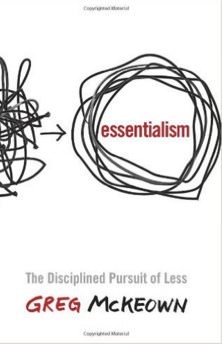 It appears as if Greg McKeown has written a book for business owners and leaders who run their business on EOS – the Entrepreneurial Operating System. One of the basic tenants of EOS is that less is more, that you have to go slow to go fast. Focus, focus, focus. Single point accountability. Essentialism: The Disciplined Pursuit of Less meshes perfectly with these concepts.
It appears as if Greg McKeown has written a book for business owners and leaders who run their business on EOS – the Entrepreneurial Operating System. One of the basic tenants of EOS is that less is more, that you have to go slow to go fast. Focus, focus, focus. Single point accountability. Essentialism: The Disciplined Pursuit of Less meshes perfectly with these concepts.
Saying no is a valuable leadership capability. McKeown provides an example with LinkedIn CEO Jeff Weiner’s leadership philosophy for which Weiner created the acronym FCS. The letters stand for “Fewer things done better,” “Communicating the right information to the right people at the right time,” and “Speed and quality of decision making.” EOS offers leaders tools to implement Jeff Weiner’s leadership paradigm in your company.
Multi-tasking Vs. Multi-focusing
Unfortunately, this hyper-connected world in which we live forces us all to be huge multi-taskers. We are expected to be available all the time. The line between our personal and business lives has blurred to the point of invisibility. And worse, McKeown points out that while multi-tasking is a skill millennials are growing up with, none of us, no matter our age, can multi-focus. Just like computers, human beings can only focus on one thing at a time.
“A true Essentialist, Peter Drucker believed that ‘people are effective because they say no.'” So, we need to be able to learn to say NO more often.
Baby Steps
But how to do that? Read the whole book, but I leave you with 8 ways McKeown offers to say NO:
- The awkward pause. [When someone asks you to do something, count to three or wait for them to fill the void]
- The soft “no” (or the “no, but”). [I would love to do X, but now is not good for me. Maybe after this project is finished?]
- “Let me check my calendar and get back to you.”
- Use email bounce backs. [Really, this is the most socially acceptable “no” there is. Don’t just use it when you are out; use it when you are dedicated to something already.]
- Say, “Yes. What should I deprioritize?”
- Say it with humor.
- Use the words, “You are welcome to X. I am willing to Y.” [When asked to drive someone – You are welcome to borrow my car. I am willing to make sure the keys are here for you.]
- “I can’t do it, but X might be interested.”
You can buy the book on Amazon here. Good luck.
Next Steps
- Start solving company issues early and quickly! Download free EOS tools.
- Request a free 90-Minute Meeting with an EOS Implementer to get a clear picture of what it looks like to run your company on EOS.





